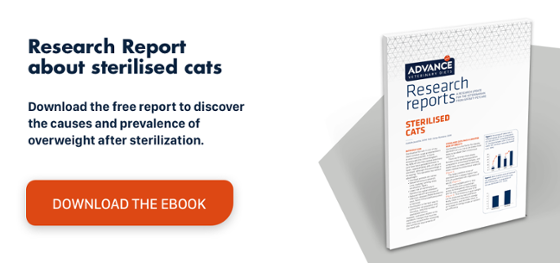Struvite uroliths: treatment
Medical dissolution
A calculolytic diet and antimicrobial therapy can help medically dissolve any struvite uroliths induced by an infection.
Antimicrobial therapy is essential for the treatment of infection-induced struvite uroliths, but is not needed in the case of sterile struvite stones. Infection-induced struvite uroliths are less common in cats than sterile ones. Antibiotic therapy should be based on the results of a urine culture and antimicrobial susceptibility tests. As the outer layers of the struvite uroliths dissolve, the bacteria that were trapped inside the stone are released. Antibiotics should be given in parallel and throughout the medical dissolution treatment, otherwise it will fail if the course of antibiotics is cut short too soon. Infection-induced struvite stones are usually induced by urease-producing bacteria (e.g., Staphylococcus spp.). However, UTIs caused by nonurease-producing bacteria (e.g., E. coli) may course with sterile struvite uroliths.
A calculolytic diet, such as ADVANCE Veterinary Diets Urinary for cats or dogs, specifically formulated to dissolve struvite stones should be administered in addition to the antimicrobial therapy. The key features of a calculolytic diet include the restriction of magnesium and phosphorus; the capacity to acidify the patient’s urine; low protein levels (fewer sources of urea); and a diuretic.
Average dissolution times are about 40–50 days.
Physical removal of uroliths
Small uroliths may be eradicated by inducing voiding urohydropropulsion to help flush them out of the urethra with the urine. The urinary bladder should be distended with sterile saline solution, either by cystoscopy or urethral catheterisation. Position the patient vertically with their spine 25° caudal to a line perpendicular to the effects of gravity. First shake the bladder so the stones settle in the vesical trigone, then squeeze it to encourage their elimination. Repeat the process until no more stones are visible via the imaging technique (i.e., cystoscopy, ultrasound, X-ray). Anaesthesia and sedation are not a prerequisite, but their use helps when performing the procedure. Stones less than 5 mm can be extracted from female cats and those under 1 mm from male cats.
Small uroliths or fragments thereof can also be removed through cystoscopy. A urolith basket can be used to retrieve stones smaller than the diameter of the distended urethra.
Laser lithotripsy involves using a cystoscope to expose the stones to a special laser that breaks them down into fragments. The fragmented pieces are then removed by cystoscopy or voiding urohydropropulsion. Laser lithotripsy has a 83–100% success rate in female cats. Note that it cannot be used successfully in small cats. Nor can it be performed on male cats.
Surgical removal options include cystotomy (e.g., abdominal keyhole laparoscopy), ureterotomy or urethrotomy. Cystostomies rarely give rise to complications, whereas ureterotomies and urethrotomies have a greater risk for complications (e.g., stenosis, bleeding, urine leakage, surgical dehiscence).
Retrograde urohydropropulsion involves expelling uroliths from the urethra into the bladder. The procedure does not eliminate uroliths, rather it transfers them to the bladder where they can be removed by a cystotomy or medical dissolution. Anaesthesia is usually required. If the bladder is too distended, first empty it by performing gentle decompressive cystocentesis to reduce urethral pressure, thus facilitating the retrograde movement of the stones. Place a urinary catheter in the distal urethra and flush with sterile saline solution (5 mL/kg).
MONITORING, PROGNOSIS AND PREVENTIVE MEASURES
While endeavouring to achieve medical dissolution, a urinalysis and urine culture should be performed 5–7 days after starting the antimicrobial therapy and then every 4 weeks until dissolution. The urine pH must be below 6.8 and the sample free from any crystals.
Screening X-rays should be performed every 4 weeks to check whether the stones are diminishing in size and/or number. Continue with medical dissolution for at least 2–4 weeks after radiographic evidence of dissolution to ensure all the stones have dissolved.
The leading causes of treatment failure in the medical dissolution of stones are the incorrect treatment of UTIs, the presence of mixed or non-struvite uroliths and poor treatment adherence.
Once the infection-induced struvite uroliths have been medically dissolved or mechanically removed, urine culture should be performed 5–7 days after completing the antimicrobial therapy and again 3–4 weeks later. Cats with a history of struvite stones should be monitored regularly through urinalyses, urocultures and abdominal imaging studies.
The most effective means of preventing infection-induced struvite uroliths is to avoid recurrent UTIs. Sterile struvite uroliths, on the other hand, are principally prevented through a diet-based treatment such as ADVANCE Veterinary Diets Urinary for cats. Diets prescribed to prevent struvite stone formation are usually low in protein, phosphorus and magnesium. They also aim to maintain an acidic urine pH and promote diuresis.
Cats given a struvite prevention diet benefit from a lower recurrence rate of struvite urolithiasis. Encourage water consumption (e.g., by adding water with a low mineral content to dry food or by placing several water bowls in different locations around the home) and improve the cat’s environment with antistress measures.

